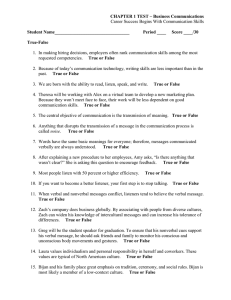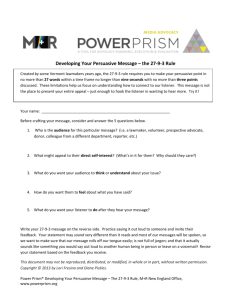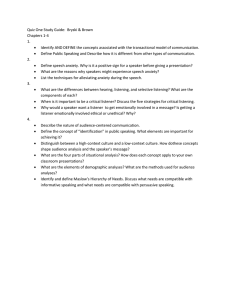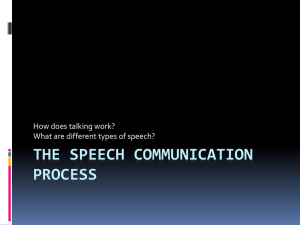The_role_of_the_list..
advertisement
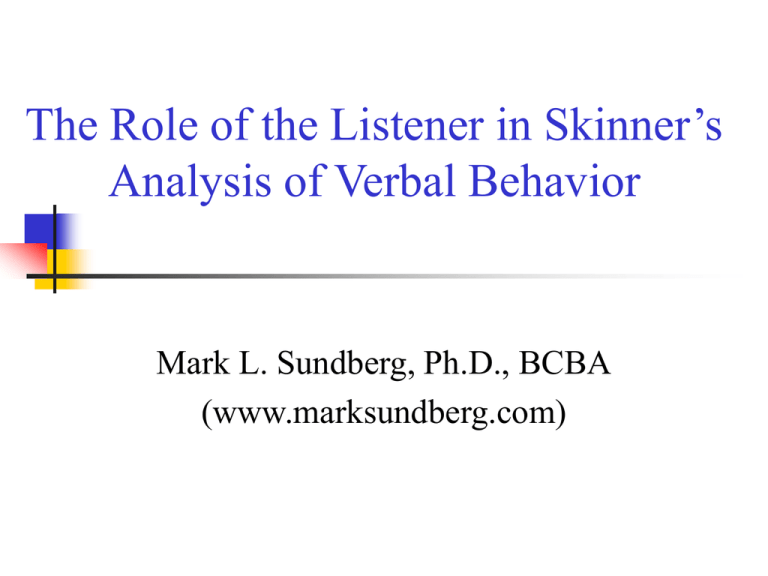
The Role of the Listener in Skinner’s Analysis of Verbal Behavior Mark L. Sundberg, Ph.D., BCBA (www.marksundberg.com) The Role of the Listener: The Problem With Traditional Views • • • • “The traditional conception of verbal behavior... has generally implied that certain basic linguistic processes were common to both speaker and listener” (Skinner, 1957, p. 33) “Theories of meaning are usually applied to both speaker and listener as if the meaning process were the same for both” (p. 33) For this reason Skinner avoided use of the common terms expressive language and receptive language because of the implication that they are merely different manifestations of the same underlying cognitive processes And, that the listener’s behavior also constituted “language” The Role of the Listener: The Problem With Traditional Views • • • “Linguists and psycholinguists are primarily concerned with the behavior of the listener--with what words mean to those who hear them and with what kind of sentences are judged grammatical or ungrammatical” (Skinner, 1978, p. 122) “The very concept of communication--whether of ideas, meanings, or information--emphasizes transmission to a listener” (Skinner, 1978, p. 122) “Much of the behavior of the listener has no resemblance to the behavior of the speaker and is not verbal according to our definition” (p. 33) The Role of the Listener: The Term “Listener” • Etymological sanctions and the term “listener” Skinner’s use of “listener” is not the same as the accepted lay use of the term (1. To apply oneself to hearing something. 2 To pay attention. The American Heritage Dictionary) It is also not the same as linguist’s use of the term • The deaf and sign language (“Observers”) • • The Role of the Listener • • • • • • What role does the listener play in Skinner’s account of language? A common position is that Skinner totally ignores the listener (e.g., Place, 1981, 1985) The word “listener” appears on at least 50% of the pages in VB There are 14 section headings (6 are major headings) containing the word “listener” Two full chapters are mostly devoted to the listener (6 & 7) “Skinner’s analysis of verbal behavior very convincingly directs our attention to the complexity of the listener’s repertoire to account for the speaker’s behavior” (Ferster, 1974, p. 155) The Role of the Listener • The problem is that there are several roles of a listener The Different Roles of the Listener • • • • 1) Necessary for a verbal episode “The behaviors of the speaker and listener taken together compose what may be called the total verbal episode” (p. 2) “There is nothing in such an episode which is more than the combined behavior of two or more individuals” (p. 2) “It would be foolish to underestimate the difficulty of this subject matter” (p. 3) The Different Roles of the Listener • • • 2) The listener consequates the speaker’s behavior Mediates reinforcement (the definition of VB, p. 2) “The verbal community maintains the behavior of the speaker with generalized reinforcement” (p. 151) The Different Roles of the Listener • • • 3) The listener functions as an SD and MO for verbal behavior (The Audience, Chapter 7 in VB) “The listener, as an essential part of the situation in which verbal behavior is observed, is... a discriminative stimulus” (p. 172) “This function is to be distinguished from the action of the listener in reinforcing behavior” (p. 172) The Different Roles of the Listener • • • 4) The listener “takes additional action” “Verbal behavior would be pointless if a listener did nothing more than reinforce the speaker for emitting it” (p. 151) “The action which a listener takes with respect to the verbal response is often more important to the speaker than generalized reinforcement” (p. 151) The Different Roles of the Listener • • • • There are three types of action Nonverbal respondent behavior Nonverbal operant behavior Verbal behavior The Different Roles of the Listener • • • Nonverbal respondent behavior “Among the special effects of verbal behavior are the emotional reactions of the listener” (p. 154) “If a verbal stimulus accompanies some state of affairs which is the unconditioned or previously conditioned stimulus for an emotional reaction the verbal stimulus eventually evokes this reaction” (p. 154) (e.g., “snake” literary works, anger, passion) The Different Roles of the Listener • • • • • Nonverbal operant behavior (“Receptive language”) Listener compliance (e.g., Jump) Listener discriminations (LDs) (e.g., Touch the car. Where is the number 5?) Listener Responding by Function, Feature, and Class (LRFFC) (e.g., Can you find an animal? Which one do you eat with?) “These examples remind us of the fact that the behavior of the listener is not essentially verbal. The listener reacts to a verbal stimulus whether with conditioned reflexes or discriminated operant behavior, as he reacts to any feature of the environment” (p. 170) The Different Roles of the Listener • • • • • Verbal operant behavior (usually, the main argument) “In many important instances the listener is also behaving at the same time as a speaker.” (p. 34) “An important fact about verbal behavior is that the speaker and listener may reside within the same skin” (p. 163) “Some of the behavior of listening resembles the behavior of speaking, particularly when the speaker ‘understands’ what is said” (p. 11) Much of what is traditionally called “listening” is covert verbal behavior, consisting of all the verbal operants (e.g., we can covertly emit echoics, mands, tacts, intraverbals, autoclitics, etc.) The Different Roles of the Listener: Summary • • • • • Skinner’s restricted use of “listener” Necessary for a verbal episode (even when the speaker is his own listener) Discriminative stimulus and MO for verbal behavior (audience) Mediator of reinforcement for the speaker (consequence) Nonverbal “action” • • • Respondent behaviors (emotion) Operant behavior (“receptive language”) When Skinner says “very little of the behavior of the listener is worth distinguishing as verbal” (1978, p. 122), these are the listener behaviors that he is referring to: The Different Roles of the Listener: Summary • • • • Excluded from Skinner’s use of “listener” Verbal behaviors (“listener” becomes a covert speaker) As a covert speaker all the verbal operants are possible When Skinner says “Linguists and psycholinguists are primarily concerned with the behavior of the listener” (Skinner, 1978, p. 122), it this covert verbal behavior that they are interested in (e.g., thinking, understanding, problem solving, processing) The Role of the Listener: What’s Missing? • • • What aspects of the listener are missing from Verbal Behavior? Skinner conceded in his 1989 paper “The behavior of the listener” that indeed the book Verbal Behavior contained “Little direct discussion of listening” (p. 86) A detailed analysis of what is traditionally called “receptive language” is missing The Role of the Listener: What’s Missing? • • • • • There is not a systematic analysis of verbal stimulus control over nonverbal operant behavior (many examples, however) Similar to the type of analysis found for mand, tact, intraverbal, etc., and their controlling variables More specifically, an analysis of verbal conditional discriminative stimuli (CSDs) that evoke nonverbal behaviors is missing Skinner did talk about the “compound verbal stimulus” (p. 76) in relation to the intraverbal Catania (1998) identified the importance of verbal conditional discriminations to all of verbal behavior The Role of the Listener: Verbal Conditional Discriminations • • Verbal CSD: Two components of a verbal antecedent where one verbal stimulus alters the evocative effect of the second verbal stimulus, and collectively they evoke a differential response For example... • • • • • • “Touch a food” “Touch a hot food” “Touch a breakfast food” “Touch a sweet food” Children with autism often have a difficult time acquiring behavior controlled by verbal CSDs, especially as the components grow beyond 2 (Verbal CSDs are also the main sources of control for most intraverbal behavior) The Role of the Listener: Research and Applications • • Verbal CSDs comprise a significant component of the antecedent variables for listener behavior, and constitute an excellent and needed area of research For example: • • • • • Listener discriminations (receptive language) (e.g., Kelly, Green, & Sidman, 1998) Listener Responding by Function, Feature, and Class (LRFFC) (Steele & Hayes, 1991) Autoclitic relations Rule governed behavior (contingency specifying stimuli, Schlinger & Blakely, 1987) However, at the current time there is very little behavioral research on multiple component verbal conditional discriminations. Hopefully, that will change Thank You! For a copy of this PowerPoint visit: www.marksundberg.com

